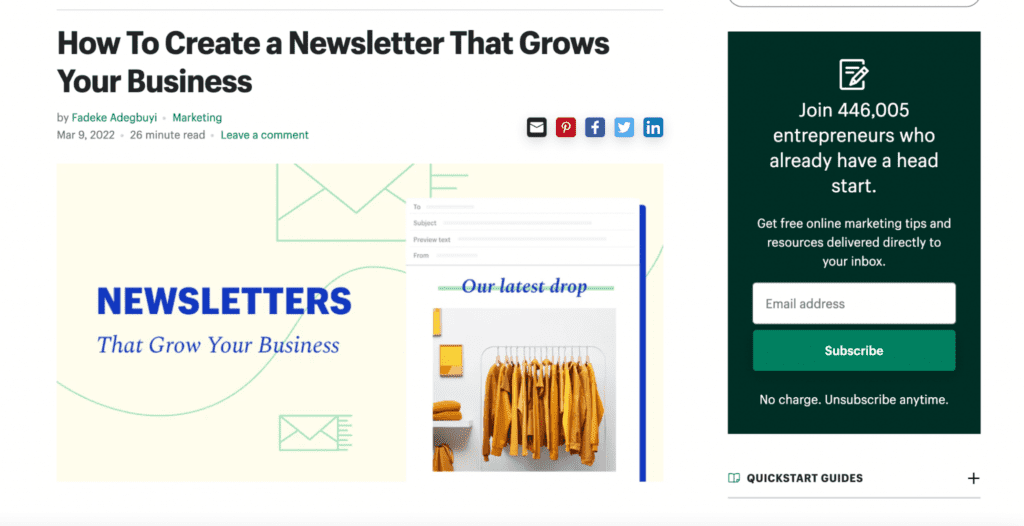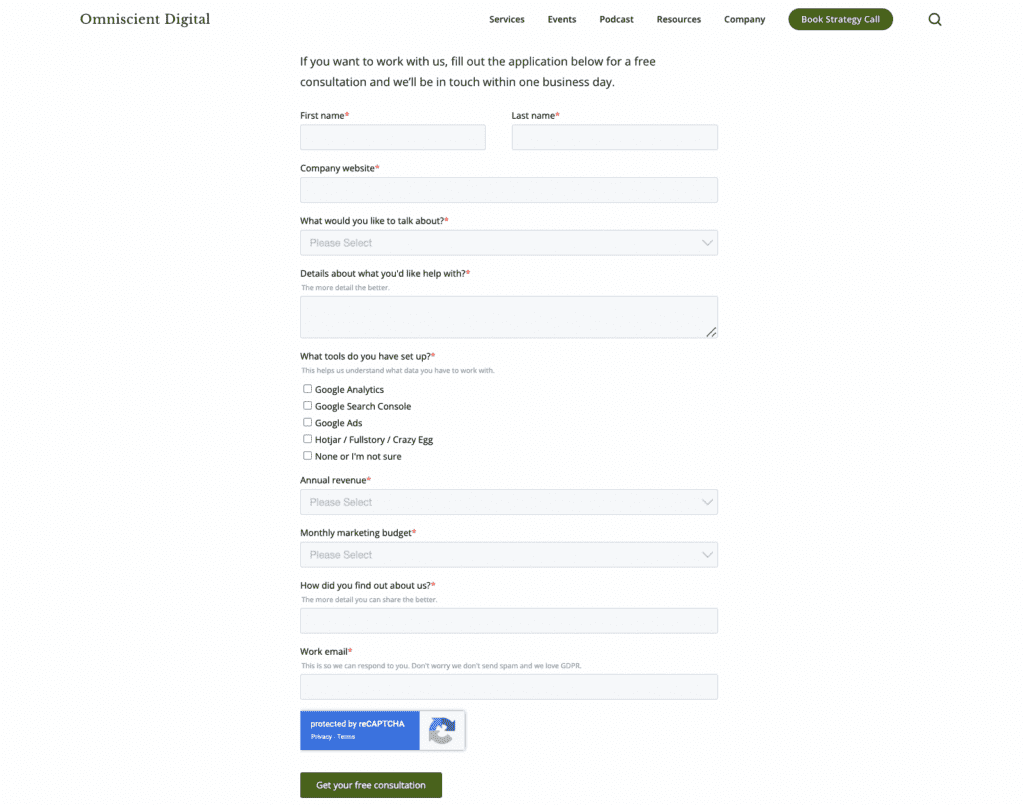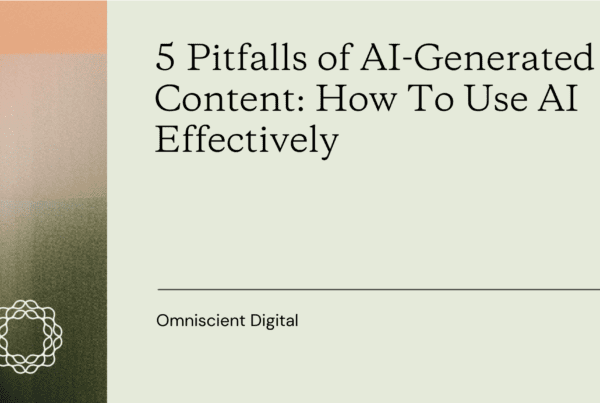
Traffic is alright.
But you know what’s awesome?
Conversions.
Most content marketers know how to drive traffic. But converting that blog traffic is always an issue.
I’ve spent a large part of my career focused on both sides of the equation. In fact, I’ve run experimentation and growth teams, in addition to having built a B2B content marketing agency.
In this post, I’ll teach you how to create content that doesn’t just drive visits and readers, but actually contributes to your business goals and content marketing KPIs.
What is High Converting Content?
High-converting content is any piece of content (e.g., a blog post, an ebook, a white paper) that’s been created with the specific goal of driving conversions.
That is, getting the reader to take a desired action, such as signing up for your email list, downloading an ebook, or scheduling a consultation call.
A conversion can be many things, from a demo request or product sign up all the way to a pitiful little email list signup (just kidding – email signups are great!).
How you define a conversion depends on your particular go-to-market strategy and business.
What “high converting” means to you is also subject to nuance. For some, a good last click conversion rate for content could be 0.5%. For some it could be 5%.
It depends what your conversion is, how well optimized your conversion funnel is, the price of your product, and more.
For what it’s worth, if you can convert above 1% of readers to some product related offer (an interactive walkthrough, a demo, freemium signup, talk to sales), that’s quite good in my experience.
For content offers (ebooks, email courses, email list signups), you should be able to convert somewhere between 1-5% of readers.
In the rest of the article, I’ll walk you through 9 tips for producing high converting content.
9 Tips for Producing High Converting Content
- Topic selection is everything
- Create product-led content
- Optimize your headline
- Benefits focused copy
- Keep it concise. Get to the point.
- Incorporate images and video
- Use effective calls to action
- Optimize your forms
- Make sure your site is technically solid and mobile optimized
1. High converting content starts with topic selection
…And topic selection starts with an understanding of your audience’s pain points.
Only after understanding the buyer’s journey, your buyers’ pain points, and search intent, can you effectively choose topics that map to those pain points (and weave your product or solution into the content). Keyword research becomes a tool to find and map to pain points, not the starting point itself.
Let’s just think about the buyer’s journey from a very high level. Say you’re selling content marketing services (meta, huh?).
Let’s take three topic ideas:
- What is content marketing (monthly search volume = 10,000)
- How to create content (monthly search volume = 1,000)
- Content marketing agencies (monthly search volume = 100)
I made up the search volumes because I want to illustrate a point about prioritization that most fail to consider: traffic for traffic’s sake is worthless.
If my price point is $10,000+ per month minimum, how many people who are looking up the definition of content marketing do you think are ready to purchase or will be in the next year?
So those 10,000 visitors, while perhaps interesting in that they could sign up for my email list, are likely less valuable than the 100 people searching for content marketing agencies.
This is all about “search intent” and the buyer’s journey. Some keywords are “hotter” than other keywords. “What is content marketing” is a cold keyword.
You always want to match your offers to the “temperature” of the keyword and buyer’s journey stage.
Johnathan Dane at KlientBoost made this point with regards to PPC campaigns as well:

So how do you choose high intent topics and keywords?
That’s a whole course on content strategy. It’s predicated on a solid understanding of your customers’ pain points and the voice of customer language they use to describe them. These often map directly to high intent keywords.
Additionally, you can use proxy metrics for the intent of a keyword. Usually, if a keyword is longer tail and higher CPC, it’s a pretty lucrative term (the thinking being if people are bidding money on it, it’s probably ROI positive).

When in doubt, look at what affiliate marketers in your space are writing about. They’re directly incentivized to drive sales (not just traffic), so their content is often very BOFU in nature.
2. Interweave your product into the content
After working with several dozens of clients as well as working in-house at startups all the way through public companies, I can tell you the easiest and most overlooked thing content teams can do is this:
Mention your product in the content you create.
Yup, that’s it.
Most content marketers avoid mentioning their product for fear of being “salesy.” But that’s silly.
First, your job is to sell things. To generate revenue. To be ROI positive. Get over the discomfort of being up front about that.
Second, you don’t have to do it in a clumsy way. We call it “product-led content” when your product is a central component to the messaging and narrative of the blog post.
Basically, you interweave your product at the right points in a blog post. If you’re writing a blog post on “how to build an email list,” for example, you might as well mention the importance of using email verification tools or that your company sells email marketing software.
Some content is naturally product-led. For instance, “Best X Tools” lists.
But even at the top of the funnel, say a piece on “the ultimate guide to email marketing,” you can almost certainly find natural points in the content to drop your product while adding value to the reader.
Ahrefs is a master at this:

3. Start with a Compelling Headline
You have a very short amount of text to make a very big impression.
So don’t underestimate the power of an effective headline.
A great headline will grab attention, communicate the value of your offer, and encourage clicks.
This is especially important for SEO, where you’ve not only got to map your blog post title to the search intent of your target keyword, but you’re competing on the SERPs for click through rate as well. That’s where a little bit of copywriting skills come into play.
For content on social media platforms, it’s also important to capture attention quickly.
Everyone’s got way more information than they could ever use or need. You need to break through the noise, not just among B2B marketers on LinkedIn, but you need to compete for attention with everything your target audience could potentially be consuming.
Headline formulas and templates for SEO are pretty straightforward: include the keyword, put a unique spin on it, but don’t get too clever.
This post, for example, is targeting the keyword “high converting content.” We could play with a few different titles:
- How to Create High Converting Content in TK Steps
- High Converting Content: The Ultimate Guide
- What is High Converting Content? + TK Tips & Examples
For social media, it’s a bit trickier and more of an art form. It also takes a lot of practice. Mischa Vaughn, who used to work on content at UpWorthy, told me on the podcast that they would write 25 headlines per blog post before choosing the final option.
For inspiration that isn’t cringey and clickbait-y, I like to look at The Atlantic:

4. Write Benefits-Focused Copy
Your readers don’t care about your product or service nearly as much as they care about how it will benefit them.
People talk a lot about benefits vs features in copywriting. But what’s is actually mean?
It means, unless warranted by the intent of the topic and the target audience’s pain points, don’t dive too far into the weeds of super niche specifications with regards to your product.
Or, at the very least, know when it is appropriate and inappropriate to go into feature details. Because sometimes features do sell.
However, in a piece of TOFU or MOFU content, you’re better off focusing on providing education through valuable content.
Let’s go back to that example of “how to build an email newsletter.”
If you spent half the article walking through the mechanics of why your form builder is technically superior to every other form builder out there, you’re going to lose the interest of the audience.

Best to sell the benefits, the future world that could be experienced by your reader, and to casually drop your product as a solution that helps get them on that path.
Copywriting frameworks like PAS and AIDA can help you with this.
6. Keep It Concise. Get to the point.
When it comes to web copy, less is almost always more. Unless you’re an awesome writer that can keep things engaging, or the context warrants depth and complexity.
Also, try to summarize the content whenever possible to make it digestible.
But as a rule of thumb, think about this question, “how long should a man’s legs be?”
Long enough to reach the ground.
Basically, even in long form content, you want to get to the point as quickly as possible and cut the fluff. Chop the long winded introduction.
Short sentences. Short paragraphs.
Write for people whose attention is splintered. Give me bullet points, headlines, subheadlines.
So aim for clarity over cleverness, and resist the temptation to stuff your pages with too much text.
The bottom line is that people don’t read online—they scan, until they’re interested enough to read thoroughly.
So make it easy for them to find what they’re looking for by keeping your copy concise and easy to skim.
This is true in long form blog posts, social media marketing, SEO content, email marketing, and pretty much any type of content.
7. Incorporate Images and Visuals
Images and other visuals are essential for making your content more visually appealing and easy to consume.
In fact, articles with images get 94% more views than those without images.
So don’t forget to add images to your blog posts and other pieces of content.
Bonus: even if the images are irrelevant, they help break up the text visually. Nothing worse than a wall of text.

Best, obviously, if the images are relevant. If you can, avoid using graphs, charts, and branded content from other blogs. Instead, create your own. It’s easy in tools like Canva.
I also love to create my own little animations and charts to showcase technical tutorials that I’m walking through.
And if it’s tutorial-based content, adding a Loom video or at least some annotated screenshots are almost more valuable that any text you could potentially write.
8. Use Effective Calls to Action
A call to action (CTA) is a brief statement or button that encourages readers to take a specific action, such as signing up for your email list or downloading an ebook. CTAs should be clear, direct, and actionable.
And they should be placed prominently throughout your content so that readers can’t miss them.
When in doubt, add more CTAs. But make the CTAs consistent. You don’t want to have three different offers. But you should have three different CTAs promoting the same offer.
I like to have:
- A text CTA in the blog introduction
- A popup overlay or slide in CTA
- A bottom of the page CTA (Brian Massey calls this a dripping pan)
You can see our email list CTA prominently on the right hand side bar:

9. Optimize Your Forms for Conversions
If you want people to take action on your website—such as signing up for your email list or requesting a consultation—you need to have forms set up on your site.
But simply having forms isn’t enough; you also need to make sure they’re optimized for conversions.
That means keeping them short (one field is ideal), making them easy to find, and using strong calls to action.
Caveat: sometimes you want to add friction to help qualify leads for your sales team.
In our case, we don’t want to be chatting with a bunch of leads who have no budget or intent to actually work with us. So our form is long AF with many fields (and automations to disqualify those without adequate budget or company size).

10. Make Sure Your Site Is Mobile-Friendly
More than half of all web traffic now comes from mobile devices, so your site must be optimized for mobile.
If it’s not, you’re likely losing out on a lot of potential leads and customers.
Fortunately, there are plenty of resources available to help you make sure your site is mobile-friendly, so there’s no excuse not to take this important step.
Conclusion
Creating high-converting content doesn’t have to be complicated or time-consuming if you know what goes into it.
By following the tips in this post—from writing compelling headlines to incorporating visuals—you can create content that converts like crazy.
Most importantly: center your content strategy on business and product goals, and interweave the product into the content itself.
Content marketing strategy should be based on marketing strategy, which maps back to business strategy. That’s what’s going to bring you to the next level and drive lead generation efforts.
Infographics are chill, but if you’re not writing about the right content ideas in the first place, they’re not gonna move the needle.
Also, overuse landing pages. That’s where you can funnel attention to a more specific message and write more sales-focused copy.
Final point: ignore bounce rate entirely. If you read any content marketer talking about bounce rate as an important metric, ignore them.



